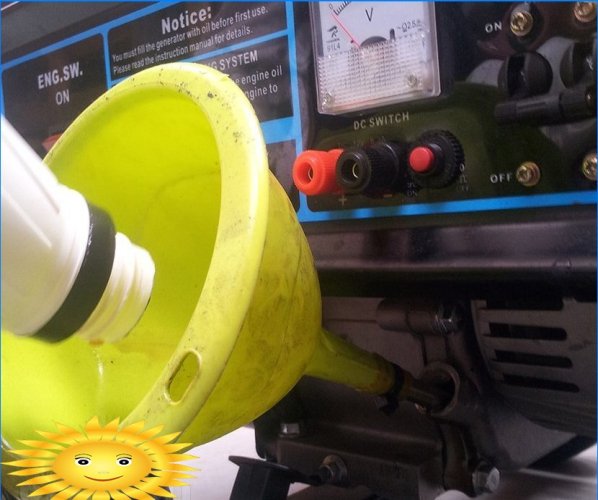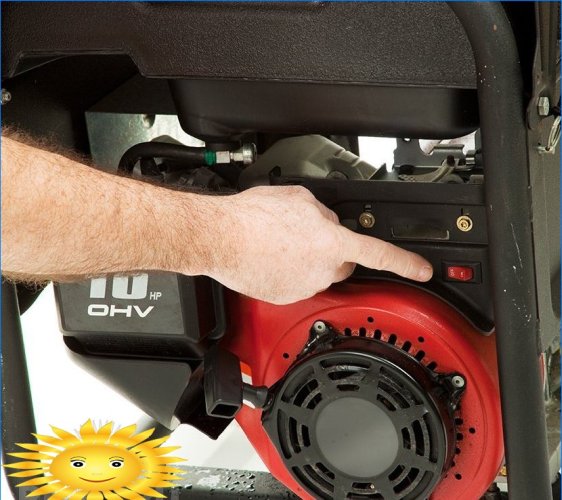Recommendation points
- Preparing to start the generator
- Refueling two-stroke gasoline engines
- Refueling four-stroke and diesel engines
- Checking the air filter
- Turning on the generator with manual start
- Switching on the generator with electric starter
- Turn off the generator
- Generator maintenance
How to start a new generator? This article will provide you with all the information you need to prepare your generator for start-up, refueling, care and maintenance. You will learn how to organize trouble-free and reliable operation of the generator by reading this article..
The device of any electric generator with an internal combustion drive engine, regardless of its power, is the same:
- Generator start block.
- Internal combustion engine.
- Oil dipstick plug.
- Electric generator.
- Generator control automation, including protection unit.
- Electrical outlets.
- Fuel tank.
- Common supporting frame-body.
Preparing to start the generator
Most of the generators sold are fully assembled at the factory, the buyer only has to fill it with fuel and oil. Before you start refueling, you need to find out which oil and fuel is recommended by the manufacturer. Depending on the type of engine, you may need:
- Diesel fuel.
- Gasoline A92 or A95.
- Methane.
- Motor oil for two-stroke gasoline engines.
- Motor oil for four-stroke gasoline engines.
- Diesel engine oil.
Refueling two-stroke gasoline engines
The cheapest generator models are equipped with a two-stroke gasoline engine. The internal structure of such an engine does not provide for a separate oil-lubricating circuit. To lubricate the engine, oil is fed into it along with fuel, where it is then burned. The standard ratio of the oil / gasoline mixture is 1 part oil to 50 parts gasoline. In such generator models, oil and gasoline are simultaneously poured into the fuel tank..
Refueling four-stroke and diesel engines
More modern engines have a separate oil-lubricating circuit, therefore, initially it is necessary to fill oil into the crankcase of the internal combustion engine, and then refuel the tank.
The amount of oil to be poured in must correspond to the volume indicated in the passport. A household generator with a capacity of 1.5–2.5 kW is usually filled with about 1 liter of oil. For refueling you need:
- Unscrew the dipstick plug on the engine crankcase.
- Fill in 80-90% of the volume of oil specified in the passport.
- Put in place and then remove the oil dipstick.
- Check that the oil level corresponds to the minimum-maximum marks.
- Add oil in small portions, each time checking its level with a dipstick. Top up until the dipstick shows an oil level that is higher than the minimum, but less than the maximum (if the distance between the “minimum” and “maximum” marks is conventionally divided into four parts, at the first oil filling, filling to? Is optimal).
- Tightly screw the dipstick plug onto the crankcase.
It is impossible to use oil that does not have the required viscosity or of another type (mineral, semi-synthetic) for filling the internal combustion engine, it is especially dangerous to mix different types of oil for filling.
Refueling is carried out into the gas tank located at the top of the generator. The maximum fuel volume is indicated in the technical documentation. There is no need to fill the fuel up to capacity. The fuel in the tank must be at least 10 mm lower than the upper wall of the tank (this condition is due to the need to compensate for the pressure created by gasoline vapors). Filling must be done through a special watering can with a mesh filter or a fabric filter.
Recently, a large number of multi-fuel generators have appeared that support the possibility of using not only gasoline as fuel, but also methane gas. To supply gas, you must use a special hose; at the point where it is connected to the gas cylinder reducer or the gas main, a separate shut-off valve must be installed.
Checking the air filter
Air filters are installed on all generators. Some of them need to be wetted with engine oil (sponge filters) for efficient operation. Before starting, it is imperative to find out the type of air filter and prepare it for operation, since the quality of cleaning the air used and, as a result, the reliability and durability of the generator’s operation directly depends on this..
Turning on the generator with manual start
Before turning on the filled generator, you need to:
- Choose a well-ventilated area.
- Install the generator horizontally.
- Disconnect the load from it.
- Connect ground.
After that, perform the following operations in sequence:
- Open the valve at the outlet of the fuel tank..
- A special air damper to restrict the air supply.
- Several times, gently pulling the starting cord towards you, lubricate the engine.
- Switch on the “ignition”.
- Pull the starter grip sharply.
- If the engine does not start, repeat the operation 2-3 times.
- After starting, smoothly return the cord to its original position.
- As the engine warms up, open the choke.
- Switch on the electric generator.
- Check the presence of voltage on the installed devices.
Since the fuel system of the new generator is filled with air, if it was not possible to start the generator after 2-3 attempts, you need to bleed air on the fuel filter and carburetor.
Switching on the generator with electric starter
Perform the first 5 points in the same way as manual launch, after which:
- Insert ignition key.
- Turn it to the “start” mark.
- Allow generator less than 20 seconds to start.
- If the engine does not start, repeat the operation after 1 minute.
- After starting the generator, return the key to the “ignition” position.
- Switch on the generator.
If the battery installed in the generator is discharged, then with the presence of the starting cord, you can start it manually.
When starting the diesel generator, it is necessary to additionally use a decompressor and de-air.
Turn off the generator
To safely turn off the generator, you need to do:
- Removing all electrical load from it.
- Close the fuel supply valve.
- Wait for the drive motor to stop.
- Disable the ignition button.
For an emergency shutdown, just press the “stop” button.
If the generator is rarely used, after turning off it is advisable to move the piston of the internal combustion engine cylinder to the uppermost position. This blocks the access to the engine of atmospheric air that can cause internal corrosion. The piston moves when the starter cord is pulled “towards itself”, the place where noticeable resistance appears will correspond to the optimal position of the cylinder piston for storage.
Generator maintenance
During operation, it is necessary to regularly check the fuel level, and when starting – check the oil level. Constantly monitor the tightness of the oil and fuel system. Generators cannot provide constant power supply. Depending on the model, at intervals of 8 to 24 hours, it must stop for maintenance (refueling, checking the oil level).
Attention! Refueling while the generator is running is strictly prohibited.!
After the first 5-10 hours of operation, an oil change is required (engine run-in). The subsequent oil change is carried out according to the schedule given in the instructions..
It is necessary at each oil change to check the condition of the fuel and oil filter, to clean the spark plug from carbon deposits. After cleaning the spark plug, it is imperative to check and, if necessary, adjust the gap between the electrodes (the optimal gap is 0.7-0.8 mm).
If the generator is operated in dusty areas, special attention must be paid to clean the air filter. The frequency of filter cleaning should be reduced to 24 hours of generator operation or less..
For long-term storage, the generator piston must be moved to the uppermost position. Place the generator in a dry, well-ventilated area. Before starting the generator, it is necessary to add fresh fuel to it (especially if a gasoline engine is installed in it).
Every 2-3 months to keep the generator in working, lubricated condition, it is necessary to start and run it until the internal combustion engine is fully warmed up (5-10 minutes).








What are the specific rules of care and operation that need to be followed for generator maintenance?
Could you please provide some insight into the rules and best practices for generator maintenance, including care and operation? As a reader, I have a generator and would like to ensure that I am taking proper care of it. Are there any specific maintenance tasks that I should always remember to perform? Thank you in advance for your guidance!